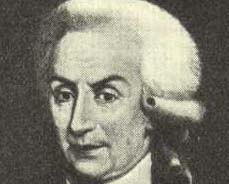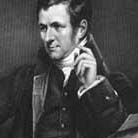 |

|

|
 |
|
|
|
|
|
|
"But what ... is it good for?" Engineer at the Advanced Computing Systems Division of IBM, 1968, commenting on the microchip. |
In 1800, Italian physicist Alessandro Volta followed the work of a friend, a physiologist, Luigi Galvani. It was Galvani who noticed that, while dissecting a frog, if he probed the dead frog's leg with two dissimilar metals, the muscles in the leg would twitch. Volta took a less gruesome approach and created the first battery. While he tried many combinations of metals, he found that zinc and silver seemed to work best. He stacked in order a plate of silver, a layer of leather soaked in brine, a plate of zinc, more leather, silver, leather, zinc, and so on. This arrangement was often called a "Voltaic pile". This discovery is truly a momentous event. Unlike static electricity which builds up on a surface and under certain circumstances discharges completely and at once, Volta's pile could produce a sustained flow of charge. At the dawn of the nineteenth century, scientists had something new to occupy their attention, and for the next several years they explored the nature of electric current as well as its effects on matter. The chemist, Humphrey Davy, used electric current to separate water into oxygen and hydrogen.
 |

|

|
 |
|
|
|
|
|
In 1826, a German mathematics professor, Georg Simon Ohm, published the results of experiments he had done with basic direct current circuits. Almost any original source describing Ohm's work uses adjectives as incomprehensible or unintelligible to describe the proofs and other thought processes he used in drawing conclusions. What he did discover has come to be accepted as a very useful empirical relationship known now as Ohm's Law. Ohm determined that the ratio of voltage (work/charge) to current (charge/time) across a metal conductor is a constant, and that that constant is proportional to a quantity called resistance, the opposition to the flow of current. We find that the factors that cause resistance in a wire include length (L), cross-sectional area (A), and something called resistivity (symbol rho). The relationship appears in the box below, right. Click here for a convenient summary of all these units and terms
Symbolically, Ohm's law is written as V/I = R or rearranging terms V = I R. If V is measured in volts (Joule /Coulomb) and current in amperes (1A = 1 Coulomb/second), then the unit for resistance is the ohm = 1 volt/amp and is usually represented by the symbol omega.
While Ohm's law is a useful relationship, it does not have the far-reaching impact of F = ma or the law of universal gravitation. V/I = R does not work for all materials; and for any given material, R is not constant, but varies with temperature of the material. Nevertheless, Ohm's law provides a useful first-order approximation that relates how current passes through components in a circuit and how voltage is distributed across those components.
Electrical components, let us consider light bulbs (or heaters or motors), may be connected in two ways. Series connections tie light bulbs together end-to-end, so that every charge that passes through one light bulb passes through the others. Actually, this is not a very good arrangement for light bulbs; if one lamp fails, none of them light. One would put a switch in series with a lamp to turn it on and off. Fuses and circuit breakers can be placed in series with other parts of a circuit to protect it from overload. Dimmer switches for lamps and volume controls for stereo equipment are connected in series with the units they control.
A second way to connect components is to use a Parallel Connection. Here, charges reach a junction and have a choice of pathways. Virtually every outlet in your house is connected this way. This allows for each unit on the circuit to be used independently of the others, provided that the total current drawn by the units involved does not exceed the circuit limit.
In the boxes below are equations that describe relationships for voltage, current and resistance. The voltage equations are a restatement of the law of conservation of energy. In the series equation, the total voltage drop for a group of resistors in series is equal to the sum of individual voltages in the group.For resistors (or anything else for that matter) in parallel, the voltage is always the same. Likewise, the current equations are a manifestation of the law of conservation of charge. For units in series, the current is always the same. When resistors are connected in parallel, charges will always distribute themselves such that the smallest resistance gets the greatest current and thereby showing that these charges do indeed take the path of least resistance.if we would pretend that the resistors were like wires, then combining the resistors end-to-end (in series) would be like making the wires longer. Connecting to resistors in parallel to be like making their cross-sectional area larger.
In electronic circuits, it is often essential to limit the current passing through a sensitive component to prevent it from frying. Often, a circuit is protected by a ceramic component called a resistor and looks like the unit in the lowest cell in the table. Resistors are sized for different numbers of Ohms and it is customary to identify the resistor value with the aid of a color code (see the table). Notice that there are colored bars skewed to the left. The first two bars left to right , red-black stand for 20. The third bar multiplies 20 by ten to the red = 10^2 = 100. Thus, red-black-red yields 2,000 Ohms. But this component costs a dime; how accurate can it be? The fourth band is a tolerance indicator silver = +/- 10%; gold = +/- 5%. Thus, the unit illustrated below should fall somewhere between 1800 ohms and 2200 ohms
| Series Connections | Parallel Connections | Useful Equations |
color code
|
|||||||||||||||||||||||
|
|
|
V = IR | ||||||||||||||||||||||||
|
|
|
|
||||||||||||||||||||||||
|
|
|
|
||||||||||||||||||||||||
|
What is red/black/red silver? |

|
|||||||||||||||||||||||||
|
Click through this applet while
it works out a simple circuit problem. Click the right-pointing
arrow and watch what happens |
|
This applet allows you to set up
different values for R & V. Try to predict what will happen
to one quantity when you change another. http://webphysics.ph.msstate.edu/jc/library/18-2/ohmslaw.htm |
|
This site provides basic theory and
two applets.Drag and drop new resistors and new voltages to see
what happens http://zebu.uoregon.edu/nsf/circuit.html#Ohm |
|
Good for basic terminology http://www.sasked.gov.sk.ca/docs/physics/u3b33phy.html |
| http://acept.la.asu.edu/courses/phs110/course_info/class_notes/electricity/electricity.html |
| http://ohmslaw.com/ |
| http://library.advanced.org/16600/intermediate/simple circuits.shtml |
|
Simple practice with Ohm,s Law |
|
http://www.phys.ufl.edu/~phy3054/dcircuit/ohm/Welcome.html http://www.phys.ufl.edu/~phy3054/dcircuit/kirch/Welcome.html |
|
In electricity, being
grounded is good. Check out http://www.eskimo.com/~billb/amateur/whygnd.txt |
| Here is an applet for your consideration |
| http://zebu.uoregon.edu/nsf/circuit.html#Ohm |
|
and another http://www.walter-fendt.de/ph14e/ohmslaw.htm |
| Go to Electrical power |
| Go to Ohm's law problems |
|
These sites are links to an entire
course in E & M http://theory.uwinnipeg.ca/physics/charge/node1.html http://library.advanced.org/16600/intermediate/staticelectricity.shtml http://www.phys.ufl.edu/~phy3054/extras/contents/Welcome.html |
| These web sites answer interesting questions about common, everyday phenomena. |
| http://howthingswork.virginia.edu/incandescent_light_bulbs.html |
| http://howthingswork.virginia.edu/fluorescent_lamps.html |
| http://howthingswork.virginia.edu/flashlights.html |
|
Light bulb history http://www.ideafinder.com/history/inventions/story074.htm |
|
|
|
|
Last edited 02/18/06